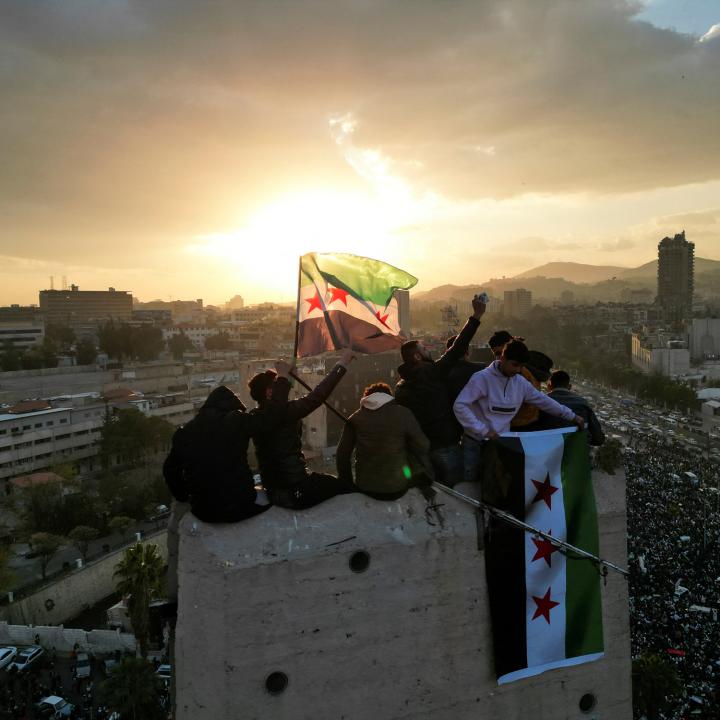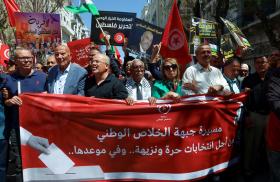
- Policy Analysis
- Fikra Forum
The Iraqi Stance on Events in Syria: Between Legitimate Fears and Sectarian Rhetoric

While Iraqi fears of a resurgence of ISIS are legitimate, understanding the realities and opportunities presented with Syria's new government while rejecting sectarian rhetoric are vital for the future of Iraq's relationship with its neighbor.
Following the recent actions by several Syrian factions led by Hay’at Tahrir al-Sham (HTS) and the rapid military victories they achieved in the countryside of Idlib and Aleppo—which culminated in the capture of Damascus and the fall of Bashar al-Assad—fears have escalated over the resurgence of jihadist narratives in the regional arena—not least in the neighboring country of Iraq. These concerns stem from either the factions themselves or the potential revival of the dormant jihadist group ISIS. In response, Iraq has declared a state of full alert and closed its land borders with Syria to prevent terrorist infiltration. Simultaneously, threats from Iraqi Shia militias have intensified, advocating for intervention in Syria to fight the armed factions, reminiscent of the events of 2011 when these groups supported the Syrian regime.
HTS was originally founded as Jabhat al-Nusra in 2012 during the Syrian civil war, acting as an extension of the Islamic State of Iraq under Abu Bakr al-Baghdadi's leadership. However, it split from ISIS in 2013, pledged allegiance to al-Qaeda, and later severed ties with al-Qaeda in 2017, rebranding itself as HTS. Despite its attempts in recent years to distance itself from global jihadism and emphasize "local jihad" as a form of national resistance, its roots remain deeply tied to extremist jihadist ideologies.
The Iraqi stance on Syrian factions varied before and after the fall of the Syrian regime and Damascus's capture. The Iraqi government maintained a consistent position of supporting the Syrian regime against the factions, labeling them as terrorists. This stance was heavily influenced by the Baghdad-Damascus relationship, shaped significantly by Iran’s role, as well as the jihadist background of Abu Muhammad al-Jolani, who leads the factions in Syria. Baghdad harbors fears of a repeat of the 2014 scenario, when ISIS overran large parts of Iraq while benefiting from a vacuum of control in Syria.
Amidst these fears, ideological mobilization of the Syrian crisis through government officials and leaders of armed Shia factions began as HTS increasingly began taking territory. For instance, PMF commanders—such as a commander in the Kataib al-Imam Ali—emphasized the symbolic significance of the Sayyida Zainab shrine in Damascus for Shia and raised concerns about its potential destruction by these factions. This narrative, historically rooted in ideological disputes over the legitimacy of religious shrines, has been adeptly exploited by Iran for recruitment and expansion under an ideological guise. Calls for intervention in Syria and combat against factions led by Jolani intensified, but the Iraqi government restricted its actions to sealing off its borders and raising military preparedness.
In an attempt to de-escalate and avoid Iraqi intervention, the Syrian Salvation Government, aligned with HTS, issued a statement to the Iraqi government on December 1 in an attempt to assure Baghdad that the developments in Syria posed no threat or cause for concern. The statement also emphasized the historical ties between the Iraqi and Syrian peoples, but it was met with rejection and disdain by the Iraqi government. The government’s response continued to refer to Jolani as a terrorist and referenced the U.S. bounty on him (subsequently lifted on December 20). In a subsequent attempt at mediation, HTS leader Abu Muhammad al-Jolani addressed Iraqi Prime Minister Mohammed Shia' al-Sudani in a video message, urging Iraq to refrain from intervening in Syria and prevent the Popular Mobilization Forces from interfering. He described Iraqi officials' fears of an expanded conflict as "baseless and unfounded." Jolani also expressed a desire to build strategic relations with Iraq based on mutual interests.
Jolani’s video message provoked strong reactions, notably from Kataib Hezbollah in Iraq, which accused him of conspiring with Israel against the Syrian people and the "Axis of Resistance." Former Iraqi Prime Minister Nouri al-Maliki, a key figure in the Coordination Framework coalition governing Iraq, labeled Jolani a criminal and terrorist, warning that Iraq would not remain neutral. The Iraqi government stated it would not respond to "terrorists" and reaffirmed its position against interference in Syrian affairs.
Yet amid these tensions, Shia cleric Muqtada al-Sadr issued a statement urging non-interference in Syria’s internal decisions and refraining from obstructing the Syrian people's aspirations to determine their own fate. He called on the government to prevent militias from intervening in Syria and, following the regime's fall, emphasized the need for a democratic government in Syria and balanced relations between the two peoples. Muqtada al-Sadr has a devoted following among the Shia community in Iraq and leads the eponymous Sadrist movement, playing a key role in the political decision-making process in Baghdad until a violent dispute between his followers and other Shia groups prompted his departure from politics in August 2022. After Muqtada al-Sadr won nearly 70 seats in the Iraqi Council of Representatives in the elections organized by former Prime Minister Mustafa al-Kadhimi, Sadr ran afoul of the Iranian-backed Coordination Framework by attempting to negotiate with Sunnis and Kurds to form a parliamentary majority.
Sadr withdrew from politics when these attempts failed, propelling his angry supporters to storm the international zone in Baghdad and clash with opposing Shia factions, highlighting the opposition role the Sadrist movement takes to the current Shia movements in power. As such, Muqtada al-Sadr represents a moderating influence in Iraq and the region when it comes to Iranian influence.
Iraq's official and unofficial rhetoric shifted after the fall of the Assad regime and the Syrian factions’ success, led by Jolani, in imposing a new reality in Syria. In a subsequent statement on December 8—the day that Assad fled to Russia—the Iraqi government stressed its respect for the free will of all Syrians, while emphasizing the importance of Syria’s security, territorial integrity, and independence. This came after Syrian army units withdrew from the Iraqi region of al-Bukamal, along with Shia groups retreating from Damascus back to Iraq.
The equivocation in the official Iraqi stance is due to both external and internal factors. The most notable external factor is the impact of Iranian influence on the Coordination Framework, which currently leads the Iraqi government. Internally, the voices of Shia groups calling for intervention in Syria have also declined, especially after Iran has attempted to engage with the new regime in Damascus as it attempts to regain some of its lost influence in Syria. While the stance of Iraqi Shia factions is partially motivated by their role in the Iranian axis of resistance, it is also driven by the looming threat of the Islamic State. The fear of a possible revitalization of ISIS is a powerful unifying force among the various militias that overshadows the differences between them and feeds into their legitimacy as groups defined by their Shia identity.
Are the Iraqis' Fears Justified?
The Iraqi people have experienced waves of varying degrees of terrorism and violence since 2003, most notably during ISIS's control of vast areas of Iraqi cities in 2014. This period was marked by atrocities including mass killings, displacement, genocide, and widespread destruction of infrastructure—some of which remains unrepaired to this day. Iraqis are right to fear and seek to prevent any resurgence of ISIS that may emerge due to the shifting control in Syria, but it is important to recognize Syrian partners in this effort—including HTS.
Public perception in Iraq continues to view Abu Muhammad al-Jolani and HTS as an extension of ISIS and al-Qaeda in spite of their control over most of Syria, the departure of Bashar al-Assad, and Jolani’s attempts at reassurance through his speeches to both domestic and international audiences. On social media, many Iraqis are drawing parallels between the rapid collapse of the Syrian regime and the swift fall of Iraqi cities to ISIS a decade ago, fueling fears of history repeating itself. These fears are valid—nobody in Iraq wants to relive such an ordeal.
However, Iraqis should realize that the evidence does not suggest that the real threat lies with Jolani or his factions, such as HTS or the Syrian Salvation Government. Rather, the threat lies in the escalation of sectarian rhetoric within Iraq that has come about during this period, which could once again nurture an environment conducive to extremism and its narratives. The relationship between HTS and both ISIS and al-Qaeda deteriorated significantly years ago, reaching levels of armed conflict, particularly between HTS and ISIS. HTS’s General Security apparatus has been actively pursuing and dismantling ISIS cells since 2017, while also indirectly targeting the group’s leaders. As for al-Qaeda and its Syrian branches, tensions have persisted since HTS formally severed ties in 2017. This includes confrontations with Hurras al-Din (al-Qaeda’s Syrian affiliate) and the "Be Firm" operations room it oversees. HTS has subsequently pursued and marginalized the leaders of these groups.
Jolani, or "Ahmed al-Sharaa" as he presents himself today, has fought against both ISIS and al-Qaeda in a bid for power and, indirectly, for international recognition and delisting HTS as a terrorist organization. His actions have contributed to the capture or neutralization of three ISIS leaders, providing a compelling incentive for collaboration on counterterrorism and other issues. Iraq could also work with Syria's new political order to prevent chaos and the emergence of a breeding ground for extremism.
A rigid focus on military measures and border security alone could backfire, inadvertently aiding ISIS’s efforts to rebuild its regional caliphate just across Iraq’s border. The group could exploit the chaos in Syria, potentially targeting Kurdish-led Syrian Democratic Forces (SDF) prisons, which are under significant strain, and the al-Hol and Roj camps. Recently, ISIS attempted—after a long absence of such operations—a failed suicide attack in one Iraqi province and even raised its flag there.
It is crucial to assess the political and security realities Jolani has imposed in Syria without succumbing to emotional or one-sided religious ideological discourse. Decision-makers must take necessary steps to ensure security and peace by working with regional and international partners to combat terrorism and prevent the resurgence of ISIS or any other extremist organization. Iraqi security agencies should adopt a more flexible approach, leveraging the opportunity to curtail ISIS’s current influence in the Syrian desert and its potential expansion. This can include opening communication channels with HTS and cooperating on counterterrorism efforts.
Efforts must also be made to block any parties seeking to revive ISIS for their own interests. In conclusion, the options available for addressing the new Syrian reality must be pragmatic. The chosen methods may not be ideal but must be realistic and acceptable, aligning with the complex circumstances on the ground.


